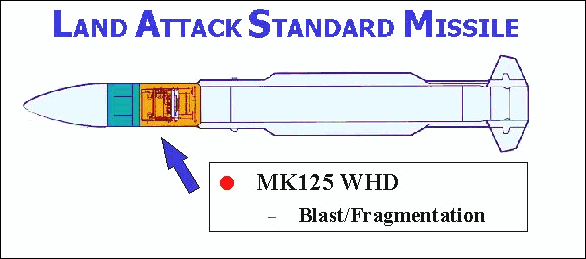Raytheon RGM-165 LASM
The LASM (Land Attack Standard Missile), sometimes also referred to as SM-4 (Standard Missile 4), was a derivative of the RIM-66 Standard SM-2MR air-defense missile. It was intended to provide long-range ship-based high-precision fire support for U.S. Marine Corps ground forces. The LASM's main targets were to be missile sites, artillery, and logistics assets.
The LASM replaced the radar seeker and MK 115 warhead of the SM-2MR Block II/III with GPS/INS guidance and the MK 125 warhead (used by the SM-2MR Block III A) in a new low-drag nose. The MK 104 rocket motor, the control section and the flying surfaces were retained, ensuring that the missile could be used with existing SM-2MR launchers. The LASM attacked its target with a near vertical approach angle, and the blast-fragmentation warhead was triggered above ground for maximum effect.
 |
| Drawing: FAS |
| RGM-165A |
After a concept demonstration of the new guidance system and warhead in late 1997, using three modified RIM-66K SM-2MR Block III missiles, development of the proper LASM began, and the designation RGM-165A was allocated. It was originally planned to convert up to 800 existing SM-2MR Block II/III missiles to RGM-165A configuration, with IOC (Initial Operational Capability) planned for 2003 or 2004. However, the LASM program was cancelled by the Navy in 2002, because the RGM-165 missile would have had only very limited capabilities against mobile or hardened targets.
Specifications
Note: Data given by several sources show slight variations. Figures given below may therefore be inaccurate!
Data for RGM-165A:
| Length | 4.72 m (15 ft 6 in) |
| Finspan | 1.07 m (42.3 in) |
| Diameter | 0.34 m (13.5 in) |
| Weight | 620 kg (1370 lb) |
| Speed | Mach 3.5 |
| Range | 280 km (150 nm) |
| Propulsion | Thiokol MK 104 dual-thrust solid-fueled rocket |
| Warhead | 135 kg (300 lb) MK 125 blast-fragmentation |
Main Sources
[1] Norman Friedman: "World Naval Weapons Systems, 1997/98", Naval Institute Press, 1997
[2]
"Vision... Presence... Power, A Program Guide to The U.S. Navy", 2000 Edition
[3] Hajime Ozu: "Missile 2000 - Reference Guide to World Missile Systems", Shinkigensha, 2000
Back to Current Designations Of U.S. Unmanned Military Aerospace Vehicles
Back to Directory of U.S. Military Rockets and Missiles
Last Updated: 28 March 2004